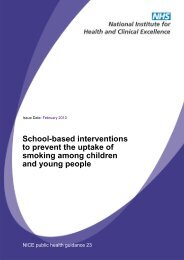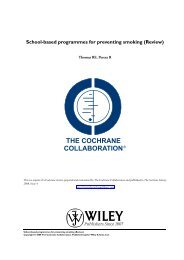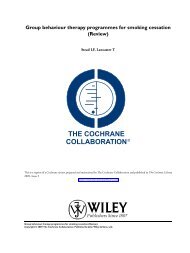Smoking and mental health - NCSCT
Smoking and mental health - NCSCT
Smoking and mental health - NCSCT
Create successful ePaper yourself
Turn your PDF publications into a flip-book with our unique Google optimized e-Paper software.
Epidemiology of the association between smoking <strong>and</strong> <strong>mental</strong> disorders 4<br />
significant association between smoking <strong>and</strong> the incidence of bipolar disorder in<br />
adults (IRR = 6.45, 95% CI 0.55–75.65), 3 but numbers were small with only nine<br />
incident cases in the cohort. Conflicting results were seen for the impact of<br />
bipolar disorder on onset of smoking in adolescence, where one study showed a<br />
significant sevenfold increase in the onset of heavy smoking in adolescents (OR =<br />
7.1, 95% CI 1.9–25.9), 27 but no significant association with onset of<br />
light/moderate smoking in adolescents (OR = 0.9, 95% CI 0.3–2.7).<br />
Furthermore, no significant association was seen between the impact of bipolar<br />
disorder on the onset of smoking in adults in two studies (OR = 0.3, 95% CI<br />
0–3.3; 27 magnitude of effect was not reported, 3 except p >0.05).<br />
4.6 <strong>Smoking</strong> <strong>and</strong> schizophrenia<br />
Five cohort or longitudinal studies of the association between smoking <strong>and</strong><br />
schizophrenia were identified in our literature search, <strong>and</strong> these are summarised<br />
in Table A3. Two of these are large cohort studies of young male army recruits,<br />
from Israel <strong>and</strong> Sweden, <strong>and</strong> report conflicting results. 28,29 The study from Israel<br />
reported an almost twofold increase in the risk of incidence schizophrenia among<br />
smokers (OR = 1.94), 29 but the Swedish study, which involved a much larger<br />
sample (48,772 vs 14,248) <strong>and</strong> number of incident cases of schizophrenia (350 vs<br />
44), found no excess risk (OR = 0.80). 28 Another study demonstrated that the<br />
time between initiation of smoking <strong>and</strong> the onset of the <strong>mental</strong> <strong>health</strong> illness was<br />
much shorter for schizophrenia than for other psychoses. 30 A more recent<br />
prospective study 31 in Danish women found that being a smoker increased the<br />
risk of developing schizophrenia spectrum disorder by about 40% (OR = 1.42,<br />
95% CI 1.12–1.80), with some evidence that risk increased with the number of<br />
cigarettes smoked per day. The study also reported an increased risk of affective<br />
spectrum disorder in those who smoked (OR = 1.40, 95% CI 1.05–1.86). One<br />
further study recruited 48 participants aged 12–30 years with prodromal<br />
symptoms (<strong>and</strong> thus at risk of developing schizophrenia) who participated in the<br />
Cognitive Assessment <strong>and</strong> Risk Evaluation (CARE) programme. 32 The study<br />
demonstrated that nicotine use was significantly associated with the development<br />
of schizophrenia (p = 0.005, Fisher’s exact test). 32<br />
Due of the lack of prospective studies, we examined an existing systematic<br />
review of schizophrenia <strong>and</strong> smoking, based on 42 cross-sectional studies from 20<br />
countries, by de Leon <strong>and</strong> Diaz. 33 The combined OR for current smoking among<br />
those with schizophrenia, compared with the general population, was 7.2 (95% CI<br />
6.1–8.3) <strong>and</strong> 3.3 (95% CI 3.0–3.6) among males <strong>and</strong> females, respectively, but few<br />
studies had adjusted for confounding. Combining these pooled estimates with<br />
three results reported subsequently in four published studies 34–37 produces an OR<br />
of 4.62 (95% CI 2.15–9.92, p














